Abstract: As an indispensable safety component for car driving, the role of automotive luminaires in the active safety of automobiles is crucial. With the advent of high-brightness light-emitting diode technology in the late 1980s, the application of LEDs in automotive exterior lighting became possible. LED has strong reliability, long service life, high color purity, fast response, small size and easy design, which makes it more and more popular in exterior lighting. In the first century, LED lights have become the new darling of the automobile trend. They are widely used in signal lamps such as turn signals and brake lights, and are applied to headlamps to achieve the combination with the AFS system.
This article refers to the address: http://
1 Introduction
In 1885, German engineer Karl. Benz developed the world's first gasoline-powered three-wheeled diesel locomotive, which was born and developed rapidly. However, in the night or in the under-lit area, there must be lighting fixtures, which resulted in the first car headlights in the 1880s, the classic car-mounted lights, which appeared in 1912. The first electric headlamp. Early car headlights used tungsten incandescent lamps, and dim lights were only suitable for slower cars. Under the situation of increasing number of vehicles and increasing speed, automobile headlights have developed into tungsten halogen headlamps with high brightness, high-intensity gas discharge headlights, and low beam, high beam and front fog lamps. Wait for multiple lights. At the same time, the lighting is only enough before the prospects, but also need to look around and avoid the worries, resulting in a series of lights such as brake lights, turn signals, rear fog lights, in order to avoid the collision of night driving or cornering when turning A key role.
As an indispensable safety component for car driving, the role of automotive luminaires in the active safety of cars is crucial. According to statistics, traffic accidents at night or under natural light account for 25% of total accidents, and 50% of casualties occur at night. In more than 100 ECE regulations, there are nearly 40 regulations related to headlights. Among the more than 70 mandatory inspections of automobile products in China, nearly 25 are related to vehicle lights.
Therefore, in order to improve driving safety, more and more new technologies are gradually applied to automotive lamps, such as fiber optic transmission technology of side turn signals, AFS technology of headlamps. Of course, this also includes the application of Light Emitting Diode (LED) in automotive lighting, especially in automotive headlamps. In recent years, in the design of automobiles, LED lights have been used more and more, which adds a modern sense to the appearance of automobiles, and is also familiar to more people, and leads the trend and direction of the development of today's automotive lamps.
2 LED technology in automotive lighting applications
An LED is an electroluminescent source that is a semiconductor device that converts electricity directly into light energy. The principle of LED illumination is to apply a forward voltage across the pn junction, so that holes in the p region will flow to the n region; electrons in the n region will flow to the p region. As the electron-hole pair recombine releases energy, some of the energy is converted to heat and the other part is converted to light. This new generation of solid-state cold light source was introduced in the 1960s, and it was initially applied in signal indications such as instrumentation and telecommunications. It formed the early application market of LED, but it could not be solved due to its performance indicators such as light intensity and light attenuation. Widely used in automotive lighting.
With the advent of high-brightness light-emitting diode technology in the late 1980s, the application of LEDs in exterior lighting signals became possible. Typical landmark events are: In 1988, Nissan first used 72 AlGaAs red high-brightness LEDs produced by STANLEY on the 280Z as the car's high-position brake lights. Since then, LED has officially entered the automotive lighting market.
In the 1990s, the material development of LEDs continued to evolve. Toshiba and Hewlett-Packard jointly developed a four-element high-brightness LED made of aluminum gallium indium phosphide (InGaAlP) in 1991. In terms of technology and mass production, it paves the way for the LEDization of automotive lighting sources.
In the first century, LED technology has advanced by leaps and bounds, and gradually replaced traditional light sources such as incandescent lamps and vacuum fluorescent lamps, which have been widely used in automotive interior lighting, operating switches, ceiling lights, reading lights, door lock lights and other interior lighting. In addition, the advantages of LED reliability, long service life, high color purity, fast response, small size and easy design have been highlighted, and it has become more and more popular in automotive exterior lighting. Especially in recent years, LED lights have been widely used in turn signals, brake lights, position lights, reversing lights, fog lights, license plate lights and other lamps, has become the new favorite of the car trend.
At present, more than 80% of European and Japanese cars are equipped with LED high-position brake lights. Several major car manufacturers in the market have also launched new cars with LED as the light source, such as Japanese, Toyota, Mitsubishi, Honda, Nissan and other manufacturers of Teana, Crown, Reiz, American General Motors' Cadillac, Buick, and Germany. Mercedes-Benz, BMW, AUDI, etc. of the car factory have adopted LED taillights, and gradually formed the industrialization of LED automotive lamps.
With the development of LED module technology, high-brightness output LED modules have also been successfully launched. For example, the white LuxeonLED module developed by Lumileds and the "OSTAR" white LED module of OSRAM make LED application on automotive headlights possible and lead. The trend of a new generation of headlamp technology. However, due to the high cost limit, current LED headlamps are mainly used in premium luxury vehicles. In 2004, the Audi A8 6. 0L luxury car used Lumileds' six white Luxeon LEDs for the first time as daytime running lights.
In 2007, Toyota Motor Corporation introduced the Lexus top hybrids "LS600h" and "LS600hL", making it the world's first production car equipped with all-white Nichia LED headlamps (see Figure 1).

Figure 1 Audi A8 daytime running lights (left) and Toyota all-white Nichia LED headlights (right)
3 LED car luminaire advantages
3. 1 Energy saving and environmental protection
In terms of luminous efficacy, with the advancement of LED material structure in recent years, the luminous efficiency of LEDs has also increased rapidly. For headlamp applications, in 2009, the luminous efficacy of white LEDs has reached 70 lm / W (see Figure 2). Moreover, LED lamps convert most of the energy into light energy, and only a small part of the heat is lost. It is estimated that replacing the halogen lamp with an LED can increase the mpg of the vehicle (the mileage per gallon of fuel) is about 0.25. 5。 When the implementation of the regulations in the daytime to be able to turn on the lights, the mpg can be increased by about 0.5. It can be seen that LED lamps will greatly contribute to the improvement of fuel economy of the whole vehicle.
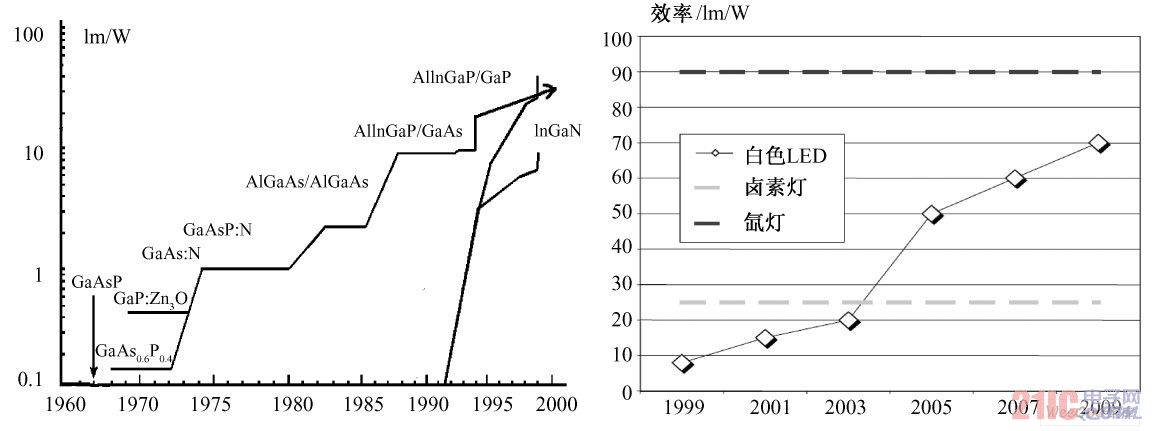
Figure 2 LED luminous efficiency trend (left) and comparison with traditional light source efficiency (right)
3. 2 front light color discrimination
At present, almost all road signs use passive glow reflection, and now LEDs with a spectrum close to daylight have been developed (see Figure 3), which makes the light emitted by it reflect the effectiveness of objects (such as road traffic signs, etc.). It is higher than other light sources, so that drivers can find out at a long distance and improve driving safety. It also helps drivers to find and see traffic signs at night as easily as during the day.
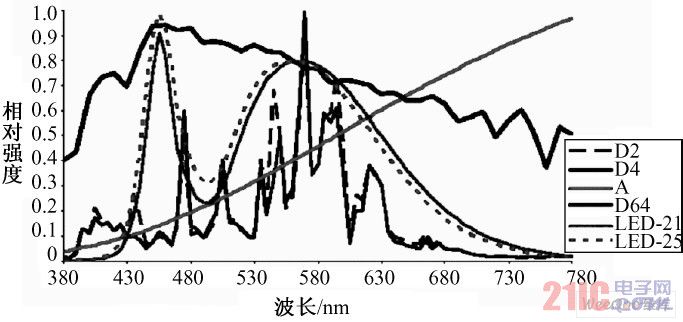
Figure 3 Incandescent lamp (A), HID (D2 / D4), white LED and daylight spectrum (D65)
3. 3 headlights anti-glare
The white LED light source has a color temperature of 5500K to 6000K, so the white LED source is closer to natural light (4800K to 6000K) than the xenon source (4000K). This light makes the driver feel less comfortable due to the light, but feels very comfortable.
Studies have shown that the short-wave phase (-450 nm) of high-intensity discharge lamps has a significant glare effect on the human eye. In the optical design of HID luminaires, it is necessary to move the bluest part of the spectrum to the edge of its spot, because these areas are the places where the driver's eyes usually do not pay attention, thus reducing the color of the light to the human eye. Uncomfortable interference. However, for the oncoming driver, the blue light will cause the other party to dazzle and affect the safety of the car when the vehicle crosses the marginal area. In view of this, in terms of anti-glare, the luminaire should be designed to minimize the light in the 450nm band and increase the light in the 450nm to 510nm band to reduce discomfort and improve the vision of the edge region. Therefore, the LED headlights can not only protect the comfort of the driver of the car, but also cause visual impairment of the driver or the driver of the car.
3. 4 short response time
In addition, the response time of the LED is short, which is generally 200 to 300 ms faster than the normal bulb response time (see Figure 4). It can be applied to high-position brake lights or turn signals. At this time, the driver can win the braking distance of 6.7m (calculated according to the speed of 120km / h) on the highway, which can reduce many accidents.
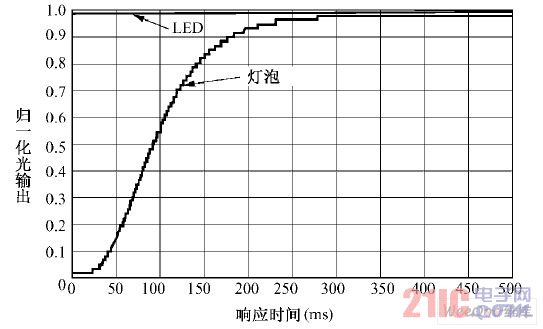
Figure 4 LED vs. traditional light source lighting time comparison
3. 5 other advantages
Compared with other traditional light sources, LED light source has significantly longer service life, less maintenance, strong seismic performance, less total heat generation, no Hg and other elements, and less environmental pollution. In addition, LEDs are small in size, and one lamp can be used simultaneously. The LED module makes the optical design of the luminaire more liberal, and this advantage is particularly prominent in the concept car.
Moreover, LED technology is digital compatible and can be integrated into digital networks to facilitate electronic control of lighting.
4 LED automotive lighting technical problems
The application technology of LED automotive lamps has matured in signal lights. The current difficulties are concentrated in the breakthrough of the headlight technology bottleneck, which is reflected in the following aspects:
4. 1 heat dissipation
The brightness of the highlighted LED is maintained, and one of the most difficult problems to solve is the heat dissipation problem. As long as the LED die encounters high temperatures, the luminous efficiency is attenuated or even damaged (see Figure 5). Although low-energy LED devices generate much less heat than halogen or HID luminaires, most of the latter heat is generated outside the luminaire, while the heat generated by the LEDs is transmitted inside tiny silicon wafers. . In this way, less heat is concentrated on the chip-sized device for conduction and divergence, as the device's small thermal capacity can also cause a sudden rise in LED temperature. The operating temperature of the LED must be kept below 150 °C. It is generally recommended that the LED operating temperature be below 80 °C. Therefore, how to make LED lights work smoothly through high-efficiency heat dissipation technology has become a key challenge for LED lamp design.
One solution is to use a larger number of LED illuminating elements in a single luminaire, so that the heat of the individual pieces is smaller, and then they are placed in a larger space to make them easier to dissipate heat. This is the method used by the small Xenon headlights for Toyota's Lexus LS600h. Valeo uses a thermal management strategy: It sets a working mode for LED luminaires. When the temperature of the luminaire rises to a predetermined warning value, it automatically switches to a security mode that reduces the power supply of the luminaire by 20%. This level of power reduction has little effect on the brightness of the light, but it can significantly suppress the level of heat. In addition, in the field of heat dissipation research, there are even airflow refrigeration and liquid refrigeration.
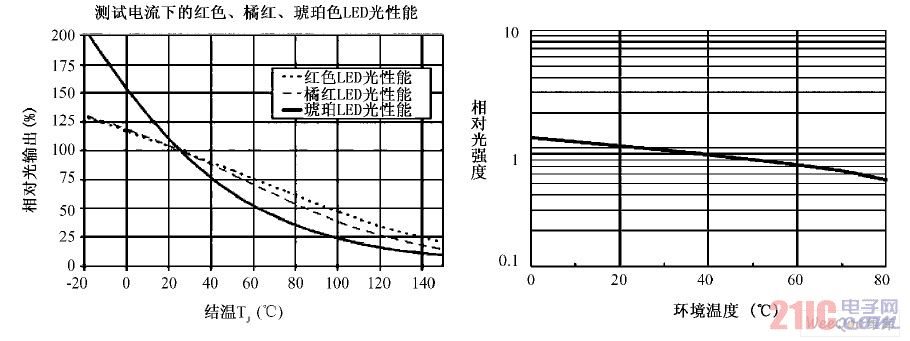
Figure 5 LED luminescence performance and junction temperature, ambient temperature
4. 2 brightness output
The study pointed out that in order to achieve better headlight illumination conditions, the best case is that the near-beam luminous flux is about 1100 lm (the luminous surface is 3500 cm2, the exit diffusion angle is 45°), and the brightness is 90 cd/m2.
Multiple LED combinations can be used to meet the 1100lm luminous flux requirement, but in terms of brightness, a single common LED source is still insufficient (see Figure 6). It is difficult to achieve the following goals when the single point is not bright enough: The number of LED light sources constituting the combined luminaire can be reduced, which helps to reduce the space occupied by the automobile luminaire and is easy to flexibly arrange, and simplifies the wiring and installation of the lighting system, thereby reducing the production cost.
4. 3 Price
The main obstacle to the development of LED lamps in the Chinese market is the cost issue. The production technology of LED chips is difficult and the threshold is high. The temperature, humidity, power supply and dust removal requirements of the crystal growth process are very strict. In the initial stage, it is necessary to invest heavily in building factories. At present, the main source of LED chips is Taiwan, which accounts for 47% of the LED market. Most of the LED factories in mainland China are resin-packaged, and the chips need to be imported in large quantities, which is the reason for the high cost.
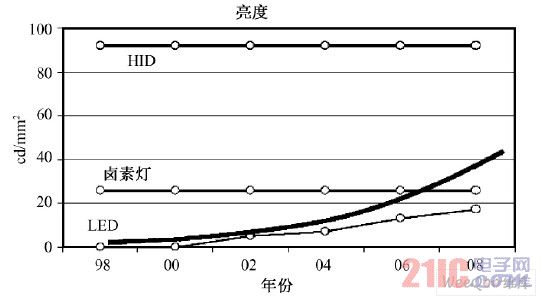
Figure 6 LED and traditional light source brightness output comparison
5 LED automotive lighting development prospects
5. 1 brightness output
In recent years, high-brightness LED technology has developed rapidly. As of 2008, OSRAM Opto Semiconductors has introduced the new OSTARHeadlamp LED. The luminous flux generated by the OSTAR Headlamp LED depends on the number of chips connected in series, 125 lm (single chip) at 700 mA and 1000 lm (5 chips) at 1A. In the meantime, the brightness requirements required for the headlights can be achieved. High-precision engineering, built-in shutter function, optimal chip mount and package design give OSTAR Headlamp LEDs new brightness data and precise cut-off lines for all headlamp designs (see Figure 7).
The Audi R8 uses the OSTAR Headlamp LED from Lumileds and Osram. Its LED headlamps are fully functional, including low beam, high beam, daytime running lights, front turn signals and front position lights (see Figure 8). Each headlamp group uses 54 LED light sources, and its low energy consumption is one of its features: Low beam lighting consumes only 50 watts and daytime driving consumes only 6 watts.

Figure 7 OSTAR Headlamp LED with new brightness data and precise light cutoff
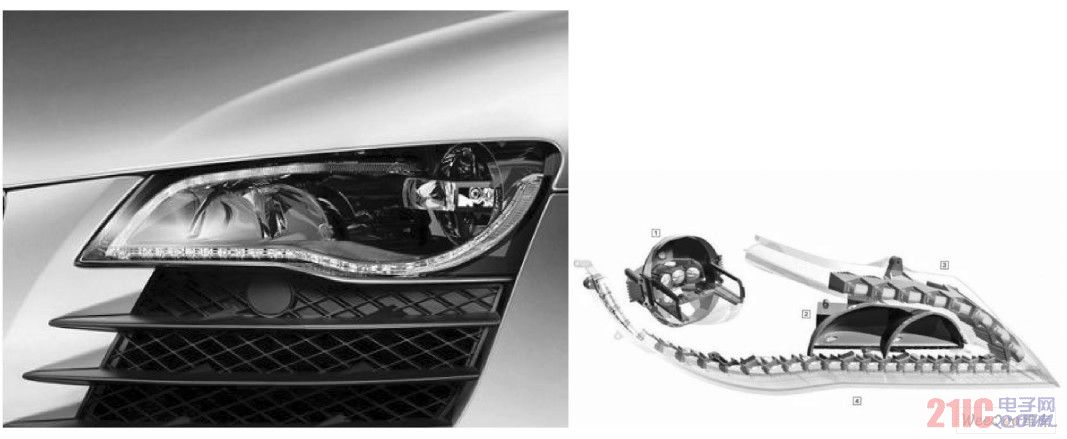
Figure 8 AUDI R8 full LED headlights
This new LED light source provides unprecedented flexibility in the style and styling of automotive luminaires, and the LED light output power density is technically comparable to HID luminaires. Therefore, once the cost can be reduced and the mass production is technically achieved, it is very promising to eliminate the existing other lighting technologies and dominate the market.
5. 2 Regulatory support
The use of LEDs in the headlights has been approved in the ECE or SAE regulations. Not only that, but for the lighting of automobile lamps, developed countries such as Europe, the United States and Japan hope to stipulate in legislation that the adjustment of the lighting angle design can improve the problem of insufficient lighting angle or road reflection caused by turning the car to achieve the best illumination. Benefits and reduce the incidence of traffic accidents. This is the AFS system (active headlamp lighting system). In July 2009, China also began to propose a draft for the development of standards for AFS lighting systems, which is expected to be available in the next two years.
5. 3 LED and AFS systems
The combination of LED headlamps and AFS systems has some advantages that traditional light sources cannot match. LED headlamps can use the array of light spots to combine the active illumination of the headlamps to achieve an active security function that changes the direction of light illumination as a function of steering angle, without the need for any moving parts. This active headlamp illumination system may require a larger number of light pipes than previously used to form a lattice. This change in the lighting system also complies with and reflects the general trend that the mechanical functions of contemporary automobiles are gradually being replaced by all-electric systems.
The same set of LED arrays can be used either as a headlight source or as a turn signal, but with separate optical mirrors for different illumination functions. As a general turn signal, it is only necessary to arrange LED arrays on both sides of the body, plus a simple switching function. In order to play the active security role of the intelligent headlights, the headlight beam always illuminates the road ahead with the vehicle's steering trajectory, so it is necessary to arrange more light source lattices and take more complicated light spot electronic control. According to the steering input, the light and dark combination of the light spot array and its mirror are controlled, thereby synchronously changing the direction of the headlight beam to realize blind spot illumination during the turning of the vehicle (see Fig. 9).

Figure 9 Traditional headlights (left) and AFS headlights (right) Curved blind spot lighting effect
This combination of advantages with AFS technology will make LEDs the replacement of other traditional light sources in the field of vehicle lighting, making it an inevitable choice in history.
5. 4 Total market value
As the LED technology continues to advance, the willingness of the car manufacturers to introduce is gradually increasing. According to the US research institute SU, the global automotive LED output value is about 700 million US dollars in 2007. In the future, the proportion of LED lamps imported by the car manufacturers will increase. By 2010, the output value will exceed 1 billion US dollars. In the field of automotive headlamp applications, it is expected that by 2012, the LED headlamp market will reach 80 million US dollars.
6 Conclusion
Since the 1980s, LEDs have become more and more widely used in automotive exterior lighting because of their high reliability, long service life, high color purity, fast response, small size and easy design. After entering the first century, LED technology has developed rapidly, especially in recent years. Some breakthroughs in light output and heat dissipation have enabled LEDs to be applied to headlamps and combined with AFS systems to become the new favorite of automotive trends. This kind of development has very important practical significance in the design of automobile fashion and the improvement of active safety.
Aluminium Alloy Phone Ring Holder
Aluminum alloy ring custom: Aluminum alloy ring are mainly made of aluminum alloy, zinc alloy, Using a new type of nano enhanced adsorption soft mobile phone not afraid of falling,Can be washed dry, you can restore as before;With car hook more heart,Metalmatte texture color is rich.
It also called: mobile phone ring brackets, mobile phone buckle, finger buckle, mobile phone ring, ring bracket, mobile phone holder, 360 bracket, ring frame, mobile phone grip Mobile phone ring frame, iphone mobile phone bracket, ring bracket, finger buckle hook, mobile phone ring bracket.
We also can customize Logo and accroding to your demand products you want. Some design gift is also can be customized. There is nothing we cannot do but something you cannot predict.
Aluminium Alloy Phone Ring Holder
Aluminium Alloy Phone Ring Holder,Portable Aluminium Alloy Phone Ring Holder,Aluminum Alloy Phone Stand Ring Holder,360 Rotation Phone Ring Holder
Dongguan Qilong Electronic Co., Ltd. , http://www.venicen-ringholder.com